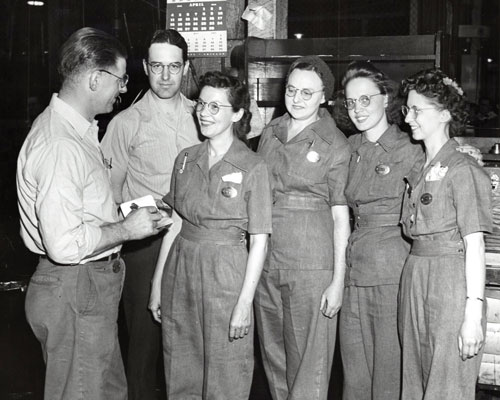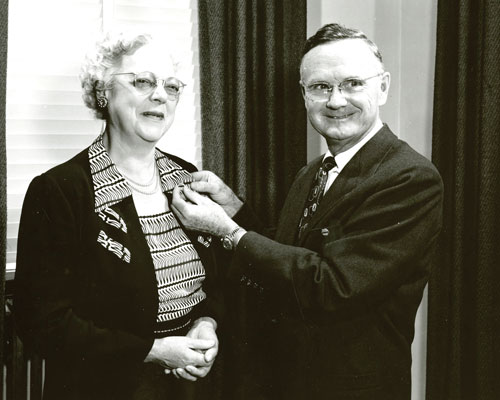From the first machine operators in 1885 to the “Women to Watch” list in 2017, women have enriched the company at all levels.
Women have worked at Caterpillar for over 100 years, going all the way back to its two predecessor companies, Holt and Best. At first, the jobs available to women were limited to the social norms of the day. Their work was primarily in office spaces and included positions such as tabulators, nurses, file clerks and secretaries. Positions in management and engineering, as well as work on the factory floor, were generally considered off limits.
With the advent of World War II, that was all to change. Women at Caterpillar not only filled positions left vacant by the men fighting overseas, but contrary to popular belief, many of them also kept working in these jobs after the war ended. These brave women, along with countless others before them, created a legacy for all of the women who work at Caterpillar today.
 First Women Machine Operators
First Women Machine Operators
More than 130 years ago, Orra Dowell, Gertie Sawyer, Lillian Dowell and Nellie Packwood set out to prove that women could be just as productive at working machinery as their male counterparts. They also may have been the first female operators of what would eventually become a Caterpillar machine.
In 1885 they requested the surrender of a Holt Caterpillar Combine from their male counterparts, who were operating the machine in the wheat fields of California. The men left from their positions, and the women assumed full control of the big harvester. Orra took her place in the driver’s seat and guided the 26 head of horses around the field; Gertie attended the header; Lillie was the sack sewer; and Nellie tended to the separator.
The women ran the harvester until noon, when they triumphantly turned it back over to the men. Their success led them to be affectionately dubbed the “Bloomer Girls” by their male counterparts. The “Bloomer Girls” probably did not realize the importance of what they did, but in a small way, the walls of gender equality began to crumble in the fields of California that day.
Caterpillar’s First Lady
Ella Chisholm was known as Caterpillar’s “first lady” because she is believed to be Caterpillar’s first female employee. Ella began her career in 1906 in Stockton, California, when she was hired by the Holt Manufacturing Company to fill a two-week stenographic assignment. She loved her assignment so much she never left.

During her tenure with the company, she had the opportunity to work as secretary for some of the most well-known Caterpillar leaders, including Benjamin Holt, C.L. Best and R.C. Force. When she received her 45-year pin in 1951, she was only the fourth employee ever to have reached the mark. C.L. Best, one of Caterpillar’s founders and former chairman of the board, was the first, with over 50 years of service.
Ella said she always wanted to be remembered for her charitable work and for founding the Caterpillar Girls' Club in 1938, a club in which she was given lifetime membership for her inspirational leadership.
Aiding the War Effort
During World War II, American women entered the workforce in unprecedented numbers, especially in industries involved in war production. Companies like Caterpillar heavily recruited women workers to replace men who had been sent off to fight in the war. The U.S. government's "Rosie the Riveter" propaganda campaign encouraged this transition and created a symbol of inspiration for working women in America.
For the first time women were able to take an equal place with men in the factory. Standing side-by-side with men, women at Caterpillar worked on all aspects of production and assembly. Women such as Doris Porzelius were hired as acetylene welders. Others worked to produce Howitzer cartridges, radial tank engines, track-type tractors, generator sets and motor graders. A year after the beginning of the war, employment at Caterpillar rose from 11,000 to over 20,000 people. In 1943 alone, 3,000 women were placed in jobs on the factory floor.
At the end of World War II, Admiral William F. "Bull" Halsey commented, "The four machines that won the war in the Pacific were the submarine, radar, the airplane and the tractor-bulldozer." Many of those tractors were built in East Peoria by Caterpillar women.
Postwar and New Positions
Breaking down the barrier to the shop floor was just the first step in a long march toward equality in the workplace. In the latter half of the 20th century, pioneering women at Caterpillar found success in positions that would have been unavailable to them before the war.
Virginia Spalding, who was employed in Purchasing, was the first woman employee to receive an award from the Labor-Management Committee for a suggestion to improve plant efficiency. Olive Pinos became the first woman to work in the research laboratory in Building W in East Peoria. She was said to be an expert with a slide rule and created first-class blueprints. Olive said she enjoyed her work immensely and that her coworkers “were a grand group of fellows.”
Lois Garton became Caterpillar’s first woman chemist after receiving her degree in chemistry from the University of Oklahoma. She worked in research and development in East Peoria and later at the Technical Center in Mossville. Ever the comedian, Lois once advertised to her coworkers that she had developed a new test to verify if a diamond was real. It seems that a diamond pressed against a piece of dry ice will emit a peculiar sound, whereas an artificial diamond would not. She told all new brides to bring in their diamonds to be tested.
Today, you will find women working at all levels of the organization, in every type of occupation imaginable, enriching the company with their knowledge, skills and abilities. Just this September, Caterpillar Group President Denise Johnson was named to Fortune‘s “10 Most Powerful Women to Watch” list, which spotlights women who are making an incredible impact on the world and are on their way to even greater achievements. The 2017 “Women to Watch” list named an impressive group of “business superstars” from companies such as Starbucks, Instagram and Uber. The list is connected to the annual “Most Powerful Women” list, which also included Caterpillar board member Debra Reed. We owe all of the Caterpillar women who helped create this legacy a great debt of gratitude. iBi


